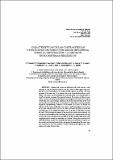Por favor, use este identificador para citar o enlazar a este item:
http://hdl.handle.net/10261/24415COMPARTIR / EXPORTAR:
 SHARE SHARE
 CORE
BASE CORE
BASE
|
|
| Visualizar otros formatos: MARC | Dublin Core | RDF | ORE | MODS | METS | DIDL | DATACITE | |

| Título: | Características de las costras físicas y biológicas del suelo con mayor influencia sobre la infiltración y la erosión en ecosistemas mediterráneos |
Autor: | Chamizo, Sonia CSIC ORCID; Rodríguez-Caballero, Emilio CSIC ORCID; Miralles, Isabel CSIC ORCID; Afana, Ashraf CSIC ORCID; Lázaro, Roberto CSIC ORCID; Domingo, Francisco CSIC ORCID; Calvo-Cases, Adolfo; Solé-Benet, Albert CSIC ORCID; Cantón, Yolanda CSIC ORCID | Palabras clave: | Costra física Costra biológica Escorrentía Erosión Semiárido Soil crusting Biological soil crusts Runoff Erosion Semiarid |
Fecha de publicación: | 30-dic-2010 | Editor: | Consejo Superior de Investigaciones Científicas (España) | Citación: | Pirineos 165: 69-96 (2010) | Resumen: | [ES] Las costras físicas (CFS) y biológicas (CBS) del suelo ocupan una
gran extensión en zonas áridas y semiáridas de todo el mundo. En estos medios, el
encostramiento del suelo tiene una gran influencia sobre los procesos hidrológicos y
erosivos. Los objetivos que se persiguen en este trabajo son: analizar las características
de las costras que influyen en la infiltración y en la erosión e identificar cuáles
de estas características tiene una mayor influencia sobre estos procesos. En dos áreas
semiáridas representativas en la provincia de Almería se identificaron los principales
tipos de costras físicas y biológicas. Para cada tipo de costra, se analizaron las
características físicas y químicas de la propia costra y del material subyacente, así
como su rugosidad, hidrofobia, resistencia a la penetración y cobertura de diferentes
comunidades de organismos. Para analizar la influencia de las costras sobre la infiltración
y la erosión, se llevaron a cabo simulaciones de lluvia en parcelas con la costra
intacta y para examinar los efectos de las características del material subyacente
a la costra, los experimentos de simulación de lluvia se realizaron tras retirar la costra.
La respuesta hidrológica de las áreas encostradas estudiadas se ve afectada no
solo por las características de la costra, sino también por las características del suelo
sobre el que se desarrollan estas costras y especialmente por la pendiente que aparece
como una variable altamente predictiva para la infiltración y la erosión. Entre las
características del material subyacente, resalta la influencia de la textura, el contenido
en carbono orgánico y la conductividad eléctrica, y entre las características de
la costra, la cobertura y rugosidad son las variables más predictivas que explican las
diferencias en las tasas de infiltración y erosión entre ambos sitios. [EN] Physical soil crusts and biological soil crusts occupy a wide extension in arid and semiarid areas all over the world. In these regions, soil crusting has a very strong influence on local hydrologic regimes and erosion. The main purposes of this paper are: 1) to examine how crust characteristics influence infiltration and erosion and 2) to identify the most influential crust characteristics on runoff and erosion processes. Two semiarid areas in the province of Almería were chosen and the most representative physical and biological soil crusts were identified at both sites. For each crust type, physical and chemical characteristics of the crust and the soil underneath the crust were analysed, as well as other crust properties like roughness, hydrophobicity, resistance to penetration and cover. To analyse the influence of the crust on infiltration and erosion, rainfall simulations were conducted on plots with the intact crust, and in order to examine the influence of the soil underlying the crust, rainfall simulations were conducted on plots after removing the crust. The hydrological response of the studied encrusted areas is affected, not only by the characteristics of the crust itself, but also by the characteristics of the soil in where the crust is developed and specially by the slope gradient that appears like a highly predictive variable for infiltration and erosion. Among the properties of the soil material below crusts, it is remarkable the influence of soil texture, organic carbon content and electrical conductivity, and among the properties of the crust, cover and roughness are the most predictive variables explaining the differences in infiltration and erosion between sites. |
Descripción: | 28 páginas, 4 figuras, 5 tablas. | Versión del editor: | http://dx.doi.org/10.3989/Pirineos.2010.165004 | URI: | http://hdl.handle.net/10261/24415 | DOI: | 10.3989/Pirineos.2010.165004 | ISSN: | 0373-2568 | E-ISSN: | 1988-4281 |
| Aparece en las colecciones: | (EEZA) Artículos |
Ficheros en este ítem:
| Fichero | Descripción | Tamaño | Formato | |
|---|---|---|---|---|
| 96.pdf | 260,87 kB | Adobe PDF |  Visualizar/Abrir |
CORE Recommender
SCOPUSTM
Citations
15
checked on 21-abr-2024
Page view(s)
1.100
checked on 24-abr-2024
Download(s)
1.189
checked on 24-abr-2024
Google ScholarTM
Check
Altmetric
Altmetric
NOTA: Los ítems de Digital.CSIC están protegidos por copyright, con todos los derechos reservados, a menos que se indique lo contrario.
